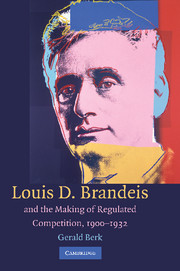Book contents
- Frontmatter
- Contents
- Figures and Tables
- Acknowledgments
- 1 Creative Syncretism
- PART I BRANDEIS AND THE THEORY OF REGULATED COMPETITION
- PART II REGULATED COMPETITION IN PRACTICE
- 5 Cultivational Governance at the Federal Trade Commission
- 6 Deliberative Polyarchy and Developmental Associations
- 7 From Collective Action to Collaborative Learning: Developmental Association in Commercial Printing
- PART III REGULATED COMPETITION CONTESTED
- PART IV CONCLUSION
- Appendix Industries and Number of Associations with at Least Substantial Involvement in Developmental Association, by Industry Group
- Index
5 - Cultivational Governance at the Federal Trade Commission
Published online by Cambridge University Press: 23 November 2009
- Frontmatter
- Contents
- Figures and Tables
- Acknowledgments
- 1 Creative Syncretism
- PART I BRANDEIS AND THE THEORY OF REGULATED COMPETITION
- PART II REGULATED COMPETITION IN PRACTICE
- 5 Cultivational Governance at the Federal Trade Commission
- 6 Deliberative Polyarchy and Developmental Associations
- 7 From Collective Action to Collaborative Learning: Developmental Association in Commercial Printing
- PART III REGULATED COMPETITION CONTESTED
- PART IV CONCLUSION
- Appendix Industries and Number of Associations with at Least Substantial Involvement in Developmental Association, by Industry Group
- Index
Summary
Between 1915 and 1932, creative syncretists at the Federal Trade Commission were remarkably successful in realizing Brandeis's proposal for cultivational governance. While they lacked the capacity to carry out cost accounting or to monitor trade agreements on their own, they found resources in civil society to construct institutions devoted to regulated competition. Deliberating regularly with cost accountants, trade associations, and the U.S. Chamber of Commerce, creative administrators renarrated the causes of cutthroat competition. Like Brandeis's engineers, they hypothesized that it was the result of cost conventions that overvalued volume. By doing so, they opened new avenues to policy experimentation and institutional design. They launched a Cost Division, published two cost accounting manuals, encouraged trade associations to design cost systems of their own, and assembled industries in deliberative conferences. Building on these initiatives, creative administrators reconceptualized the commission's role in steering competition from predation to improvement. By 1926, they had institutionalized a deliberative structure for defining standards of fair competition and reviewing associational cost accounting initiatives. In doing so, creative syncretists invented a novel form of regulatory organization, which proved effective in collaborating with professional and business associations to respond effectively to economic uncertainty, diversity, and change.
Students of state building in the 1920s do not usually recognize policy innovation at the FTC, because they see the commission's formative context as inhospitable to autonomy and policy planning.
- Type
- Chapter
- Information
- Publisher: Cambridge University PressPrint publication year: 2009



